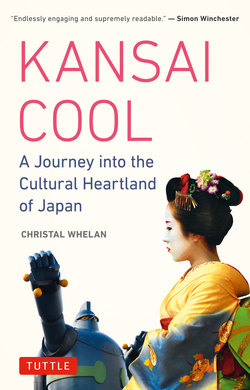Kansai Cool

Реклама. ООО «ЛитРес», ИНН: 7719571260.
Оглавление
Christal Whelan. Kansai Cool
Отрывок из книги
COOL
I would like to extend my thanks to The Daily Yomiuri (The Japan News), for whom I worked as a columnist writing “Kansai Culturescapes” from my base in Kyoto from 2011-2012, and for their permission to include those essays among the new ones in the present collection. I am especially indebted to my chief editors Yumiko Miyai and Kakuya Ishida. Thank you also, Mr. Yoshihiro Kaida of the Kyoto International Cultural Association, for permission to reprint the essay “Gratitude.” It’s the welcome mat of the whole collection.
.....
Though I am indebted to all of those mentioned above for teaching me about some aspect of Japan, and to countless others less conducive to sound bytes, I am uncomfortable with master concepts and summations that attempt to capture the main spring of any culture or civilization. However, there are two words that express approaches to life that I have found pervasive throughout Japan. They are: gambaru/gambatte, and kansha. Gambaru can mean “keep trying” or “go for it.” It exhorts a person to make the most sincere effort possible in any undertaking. It also implies that the outcome is far less important than the effort put into something. Ivan Morris captured the sentiment well in his elegant book—The Nobility of Failure: Tragic Heroes in the History of Japan—that tells the stories of various heroes who failed to attain their goals, and often losing their lives in the process. Not victorious in any simplistic way, yet in Japan they are nonetheless considered heroes. What they possessed was a spirit of gambaru as they threw everything they had into their effort. The word kansha translates as “gratitude” and is an orientation that recognizes that a person never accomplishes anything alone but rather is supported throughout life by innumerable people, the natural world, and organizations. The opposite of any notion of self-reliance, it goes a long way in keeping the ego in check.
For the most part, I have attempted through description to avoid grasping another part of the elephant myself. That said, I have allowed a few principles to guide my approach. The over-arching theme of all these chapters is cultural change and the incessant tug-of-war between preservation and innovation. I found this issue particularly acute in Kyoto, the heartland of Japanese tradition where maiko, apprentices to full-fledged geisha, can still be seen stepping from limousines in the Gion district and shuffling to their appointments in steep platform willow-wood pokkuri thongs, while Buddhist monks in straw sandals and broad conical hats that double as umbrellas roam the back streets of the city chanting with begging-bowls in hand and eat only what they receive in alms.
.....